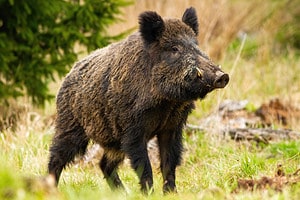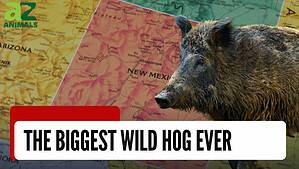Out of the 50 states, 40 of them have a big invasive species problem. The species? Feral hogs. Known as wild hogs, boars, pigs, or razorbacks, these animals wreak havoc across the country. They were first introduced into the wild by early explorers but now number in the millions. They are aggressive, unpredictable, and territorial. They’re omnivores that will attack and eat animals bigger than themselves. Annually, they cost farmers billions of dollars in destruction to crops, infrastructure, and lost livestock. In suburban communities, they are a threat to pets and children and create property damage to fencing and landscaping. Are there feral hogs in Minnesota? Where have they been found and what can be done about them?

Feral hogs are found in 40 out of 50 states in the U.S.
©iStock.com/chingkai huang
How Did Feral Hogs Spread in the U.S.?
Swine are not indigenous to North and South America but were brought there by early European explorers and colonials. Christopher Columbus brought them with him on his voyages to the New World. He deliberately released them on Caribbean islands so they would multiply and provide a food source. This was meant to aid future explorers running low on provisions.
Colonies in the islands and on the North American mainland grew. During this time, domestic pigs escaped from farms and helped grow the feral herds. In modern times, feral hogs have been introduced accidentally or intentionally by game hunters in distant parts of the country. They have also escaped from game reserves that were improperly fenced. In other cases, individuals have illegally released them to start a local hunting population. Southern states such as Texas, Oklahoma, and Louisiana have the largest wild boar populations. These animals are extremely hardy and have spread as far north as Canada.
How Many Feral Hogs Are in Minnesota?
The good news for Minnesota is that the state has no known breeding populations of feral hogs. However, recently escaped domestic pigs were discovered in the West Valley Wildlife Management Area in Marshall County. This area is in the northwestern part of the state. The hogs were traced back to the farm they escaped from, and the owner was warned, charged, convicted, and fined. The biggest concern for Minnesota is that feral herds may migrate into the state from neighboring states or from Canada.

Feral hogs in Minnesota and neighboring Canada are hardy enough to survive in harsh winter conditions.
©iStock.com/Jevtic
What Are the Dangers of Feral Pigs?
Feral hogs in Minnesota are not a current problem. However, officials still must monitor and control them, because they can quickly get out of hand. These are some of the problems they can cause:
Aggression
Feral pigs are bad-tempered and unpredictable, especially during mating season or if they think their young is in danger. They attack animals or people larger than themselves, using their tusks and teeth to bite and gore. It’s quite possible for a large boar to kill a person if wounds like this sever an artery. Swine are omnivorous, eating small wild mammals, reptiles, and birds. They will also attack young livestock such as lambs or even calves for food. They are a great danger to pets or children who may cross their paths while walking in the woods.
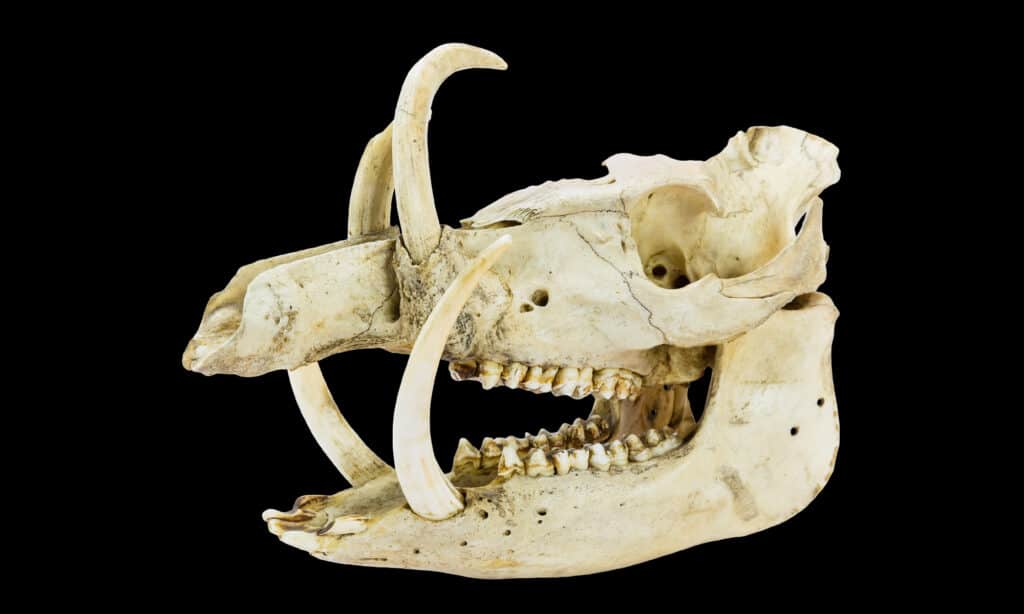
This skull looks prehistoric, but it is actually a modern wild boar. Its tusks and teeth can be deadly.
©iStock.com/Ben-Schonewille
Disease
Feral pigs can carry up to 34 different serious infectious diseases. These can transmit to other animals or people through close contact, bites, drinking contaminated water, or eating contaminated pork. Hunters in states where hunting boar is legal must take careful precautions when butchering and cooking wild pork. Pig farmers are greatly concerned that feral populations could one day bring back swine flu. This respiratory infection is deadly for pigs and was only eradicated with a tremendous effort in 1978. Feral populations could transmit such a disease rapidly from one farm to another across a wide area.
Property Damage
Wild pigs will eat all sorts of crops without discrimination, including rice, wheat, corn, soybeans, melons, carrots, pumpkins, and spinach, or roots, legumes, and tubers. They will also consume low-hanging or fallen fruit from trees and vines. Wild boar can make quick work of an entire potato field or uproot thousands of dollars’ worth of landscaping. They have destroyed turf at private homes, parks, or golf courses. These feral animals also strip bark from trees and vines by chewing on them or rubbing against them. (They do this to scratch themselves, because they are often itchy due to parasites.) Without bark, trees are vulnerable to insects and diseases.
Additionally, feral hogs are heavy and strong, so they can break down fences. They may also shove their way under them to get to food, water, or domestic animals on the other side. They root around through fields and pastures, creating a muddy mess and leaving deep ruts. These are hazardous for livestock or farm equipment trying to move through the area. According to the U.S. Department of Agriculture, feral pigs cause over $1.5 billion in damage every year to farms in the United States.

Feral pigs damage a great deal of property in their constant quest for food.
©iStock.com/JMrocek
Environmental Damage
Even if feral hogs never came near humans, they still do incalculable damage to the natural environment. Studies have shown that on average, biodiversity in forests that have wild pigs is 25% lower than in non-pig infested forests. This is because pigs root through the soil of the forest floor, overturning plants, grasses, and saplings and leaving behind a muddy mess that doesn’t have time to grow back before they’re rooting there again. They snuffle into underground burrows of ground-nesting animals, eating them if they can catch them. They are especially disruptive to ground-nesting game birds like pheasants and quail.
Herds of feral hogs are disastrous for water sources as well. They wade and lay down in the shallows of water sources, contaminating them with mud, feces, and urine. This makes the water undrinkable for some distance downstream and drives off fish, turtles, frogs, and other freshwater species.

Feral pigs root in the soil constantly. They can quickly leave a large area of forest a muddy mess.
©Slatan/Shutterstock.com
How are States Combatting Wild Pigs?
Monitoring
Even though Minnesota does not have a problem with feral hogs at the moment, wildlife officials carefully monitor the issue. They make sure they don’t cross over from other states or escape from pig farms. They also monitor for illegal release. States that do have multiplying populations try to keep track of them through a combination of citizen reports, tracking with canines and animal experts, observing areas of damage that indicate the presence of a herd, doing aerial surveillance, and using trail cameras. Feral hogs can be difficult to keep track of when their numbers are small.
Fencing
Property owners and state and local governments in areas that are badly affected by wild hogs sometimes invest in fencing. For it to work, though, it has to be super strong, tall, and buried several feet in the ground at the bottom to prevent the pigs from rooting under it. Sometimes barbed wire or electrified fencing is used. This can be an expensive solution and it requires consistent maintenance.
Hunting
Many states allow the hunting and trapping of wild hogs by properly licensed game hunters. This seems like an obvious solution. It is, after all, how other numerous species like deer are controlled in much of the country. However, other states forbid hunting wild boar for some good reasons:
- Hunting can frighten and scatter a herd into other areas, making a bigger problem and spreading the damage they do.
- Hunting can make wild boar frightened of people and more aggressive toward them. They’re then more dangerous to unarmed campers, hikers, and children trying to enjoy the outdoors.
For these reasons, it is illegal to hunt feral hogs in Minnesota. If you are a hunter and want to add a wild boar to your achievements, 28 other states do allow it and you can learn more about them at this site.
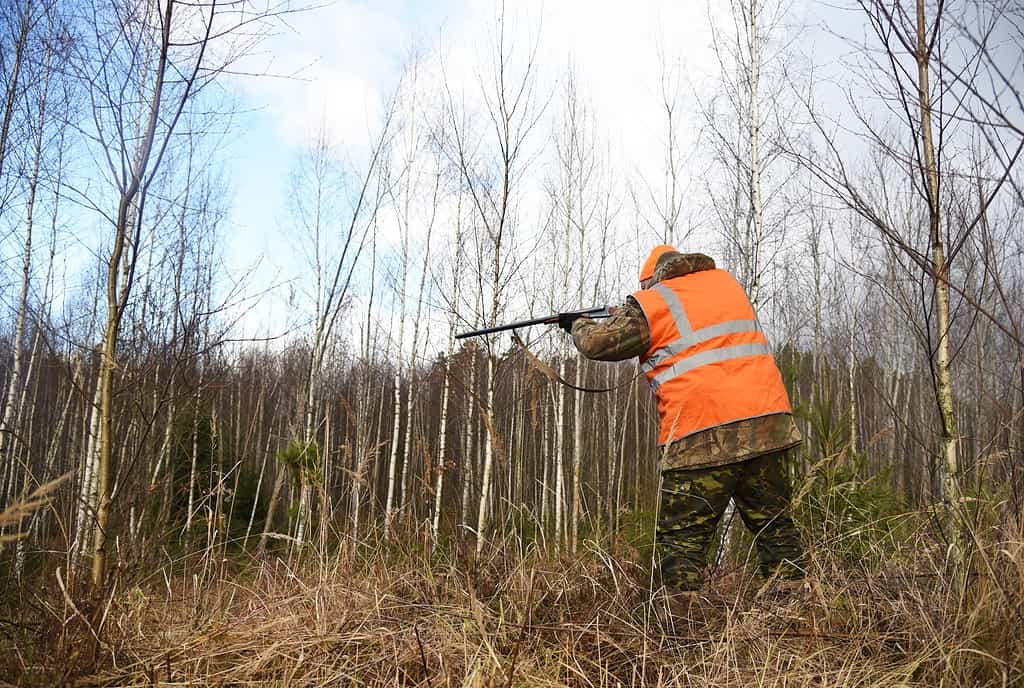
This hunter has tracked down a wild boar and is preparing to take his shot.
©Maksim Safaniuk/Shutterstock.com
Trapping
Wildlife officials often prefer trapping to hunting. Traps work 24/7. One person can set and monitor a lot of them over a large area. This makes them less labor-intensive and time-intensive than hunting with firearms or bowhunting. A problem with trapping is the possibility of capturing the wrong species. This can happen even when officials place traps in specific ways.
Poisoning or Sterilization
Poisoning and sterilization are two other methods of control. Each of these involves putting out chemical-laced hog feed in areas herds frequent. This can either kill the animals or sterilize the males for a 30-day timespan so they cannot reproduce as quickly. Each of these is problematic. It introduces a toxic chemical into the environment that could pass from the pig carcass to other animals that feed on it. And contraceptives must be repeated for the same animal every month to stop all reproduction. So neither of these is a complete and flawless solution to the problem.
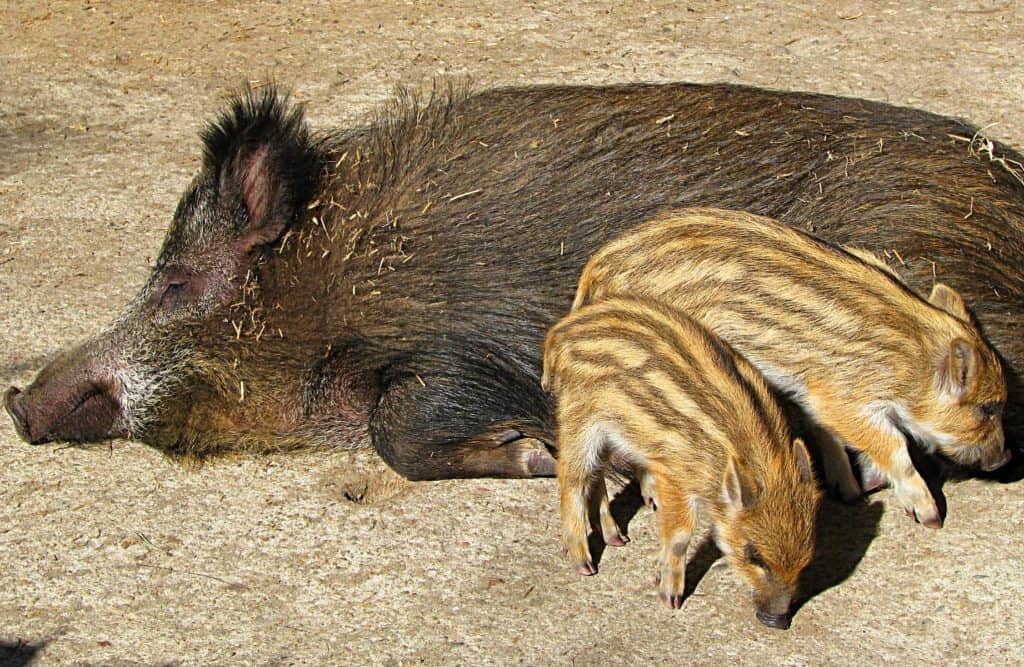
Contraceptive-laced pig feed can reduce feral hogs’ ability to reproduce.
What’s the Solution?
Feral hogs in Minnesota and around the country are a manmade problem that will ultimately require a manmade solution. This invasive species has demonstrated its ability to multiply explosively in all sorts of different ecosystems. In terms of natural selection, the only way to deal with such a species is to replace it with a stronger species that is better able to take its place in the environment. Unless we’re prepared to release large numbers of bears, wolves, and mountain lions into every part of the country, it is up to human beings to take control of this situation, reverse our mistake, and remove these creatures as humanely as possible from the environment.
Thank you for reading! Have some feedback for us? Contact the AZ Animals editorial team.





